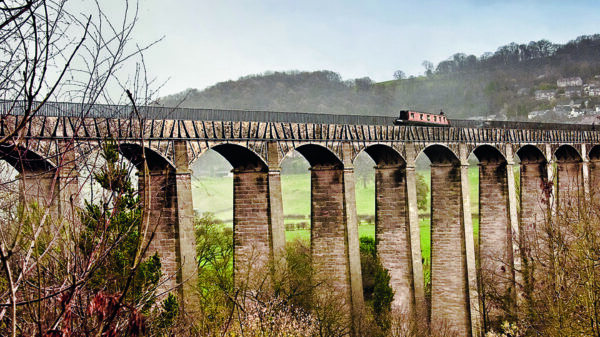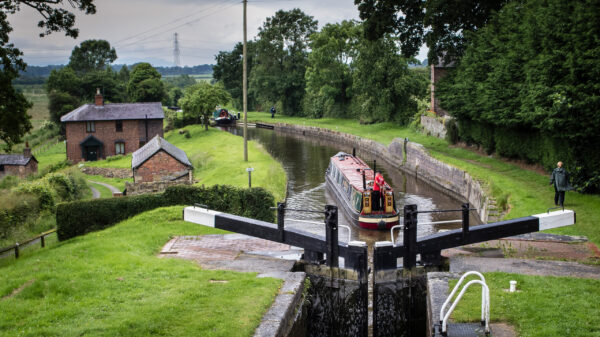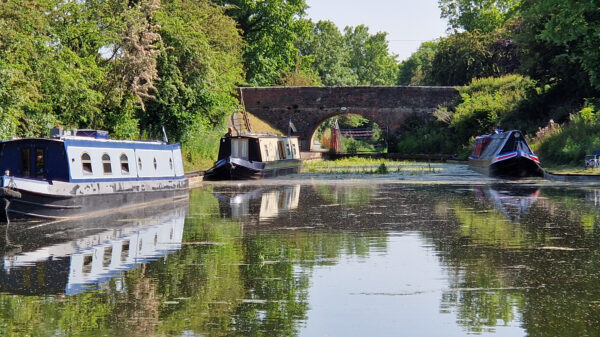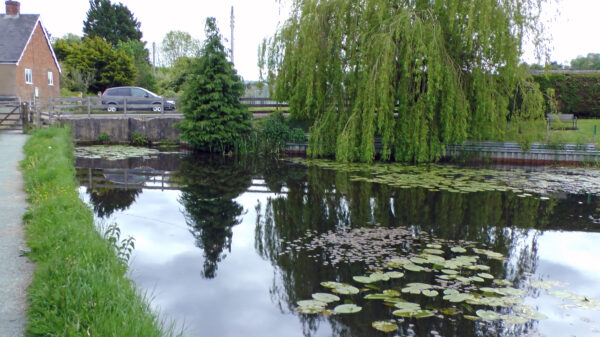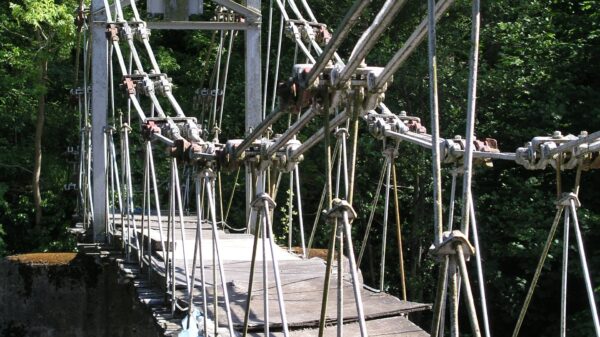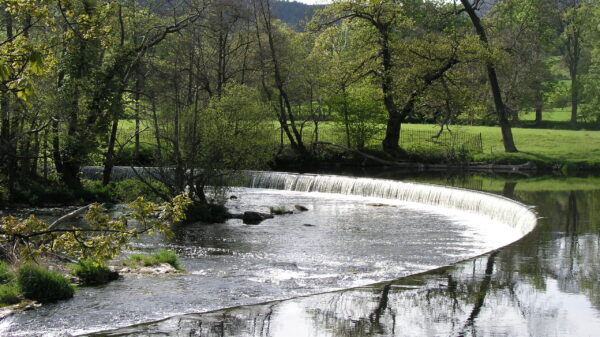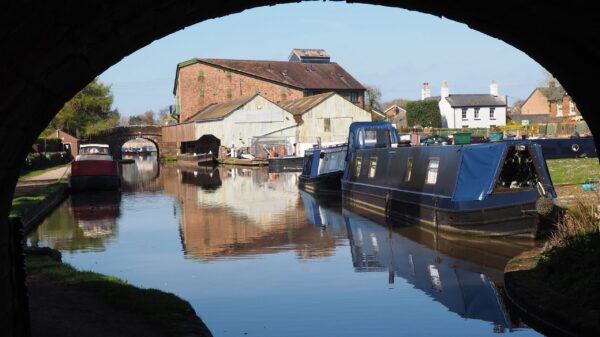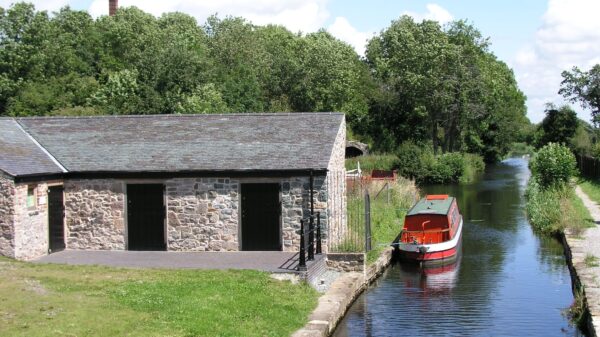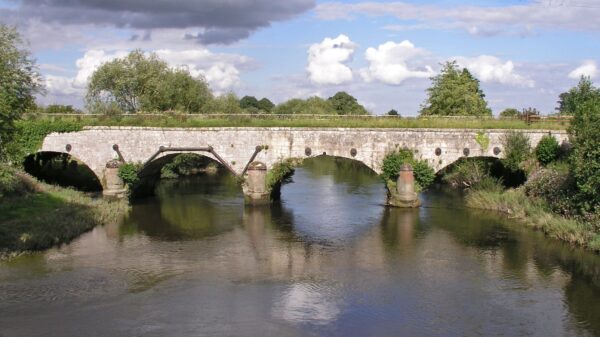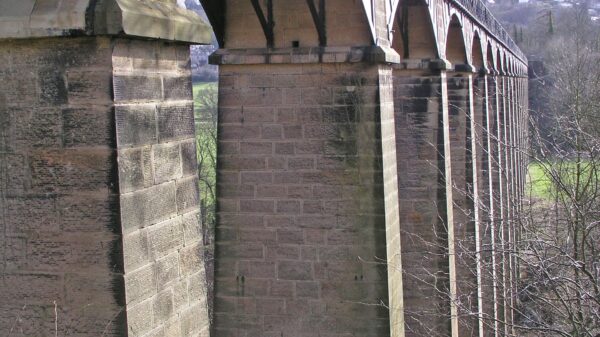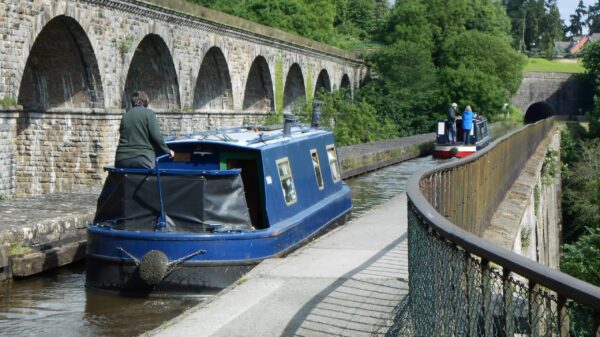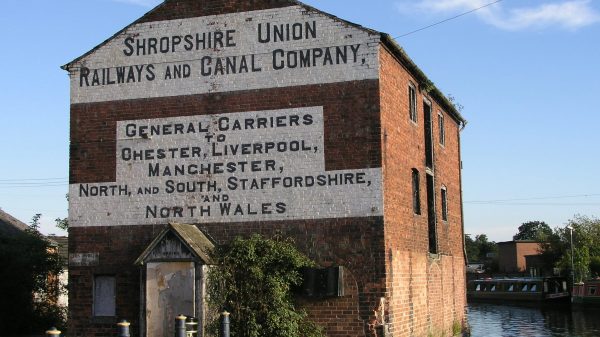Chirk to Chirk Bank and Rhoswiel Walk
Pleasantly rural and rich with heritage, this is a fascinating area of industrial and transport history, with collieries, a corn mill, turnpikes, tramroads, the Llangollen Canal and the railway.
This figure of eight walk starts at ‘Glyn Wylfa’ in Chirk and passes through fields, along the Llangollen Canal and across the Chirk Aqueduct.
This walk can be halved by omitting the loop from Chirk Bank via Rhoswiel, or by getting the bus to Rhoswiel.
Walk Details
Surface
Some of it is on field footpaths, including one steep section and stiles, so suitable footwear is essential. If you halve the walk by getting the bus to Rhoswiel, the entire route follows a well-surfaced towpath.
Parking
‘Glyn Wylfa’ (LL14 5BS) has a car park for customers. Alternatively, there is a large car park off Colliery Road (Pwll Y Waun, LL14 5PL), near the centre of Chirk village. This is about half a mile from the walk start.
Bus option
The bus option is entirely along a well-surfaced towpath and joins the route at point 7. This is a much easier walk and reduces the length to 2.8km (2 miles). Park in Chirk village and take Arriva bus 2 (hourly) to Rhoswiel roundabout. A walk of about 300 yards along the road towards Weston Rhyn brings you to the canal bridge.
Note: Both English and Welsh bus passes are valid.
Chirk to Chirk Bank and Rhoswiel Walk Map
Begin The Walk
1. Glyn Wylfa – Chirk
The walk starts outside ‘Glyn Wylfa’, Castle Road, Chirk. ‘Glyn Wylfa’, now a community building, was built in 1899 for the owner of Chirk Mill, Mr Steele Roberts.
Head east along Castle Road to the junction.
2. The Church
Cross the main road. The site of the church ahead is originally thought to be a ‘llan’ (a Welsh phrase describing a walled enclosure containing a chapel, hermit’s huts and burials) dedicated to Saint Tysilio. The first stone church was built in Chirk during the 11th Century but most of what is seen now is somewhat later.
On the right, overlooking the valley, is the site of the early 12th century motte and bailey castle.
Walk a few yards down the hill then take the footpath on the left. Be careful with your footing as you descend the steep hill, and the path re-joins the main road at the bottom of the hill.
3. Chirk Mill
At the bottom of the hill, you will see Chirk Mill is passed on the left.
The bridge over the Ceiriog was rebuilt by Thomas Telford in the early 1790s, one of his earliest bridges designed as County Surveyor for Shropshire; it was widened in the 1920s in reinforced concrete, faced with the original masonry. From here there is a good view of the canal aqueduct and railway viaduct.
In the early 19th century, there was a coal mine in the field between the bridge and the aqueduct. The workings undermined the Canal and in December 1816 the embankment failed, flooding the mine. After a legal battle the canal company was held liable because it had not bought the mining rights.
Cross over the bridge and take the road rising to the right by the Bridge Inn.
5. Footpath to Rhoswiel
The footpath to Rhoswiel starts almost immediately on the right.
Follow the footpath across several fields. Part way along, the original line of the Glyn Valley Tramway is crossed. This opened in 1873 as a horse-drawn narrow-gauge railway from Glyn Ceiriog, down the valley as far as Pontfaen, then climbed steeply to cross the ridge on its way to Gledrid Wharf (which is seen later in the walk). In 1888 it was converted for steam haulage, the western terminus altered to Chirk, and the 1½ miles from Pontfaen to the canal interchange at Rhoswiel closed.
6. Cross the final Stile
Cross the final stile, enter a yard, and leave by the lane from the far right-hand corner. There was a small colliery part way along the lane on the left. At the end of the lane, turn left, cross the Canal bridge and descend to the towpath of the Llangollen Canal.
7. Llangollen Canal
Walk north along the towpath with the Canal on your left.
The original terminus of the Glyn Valley Tramway can be seen on the opposite side of the canal. The route of some of the tracks can still be made out by the ridges in the field. Some of the stones visible at the water’s edge have hole – these were originally stone sleepers.
8. The Poachers
Continue along the towpath and you will reach a pub by a bridge. ‘The Poachers’ was originally called the ‘New Inn’.
UNESCO made the eleven miles of canal from the bridge by ‘The Poachers’ to Horseshoe Falls a World Heritage Site in July 2009.
9. Chirk Bank Bridge
Continue along the canal. After it bends round to the left, you will see where the Canal narrows. The narrows was where Quinta Bridge stood until 1903 when it was demolished to provide material to fill in a nearby breach. It has grooves for stop planks.
Follow the towpath and shortly before Chirk Bank Bridge, on the other side of the canal, is the site of a chute at the end of a tramway from Quinta Quarry. This was short-lived as the drop was found to break up the coal.
The bridge (which the walk crossed earlier) shows a very early use of cast iron beams to support a deck, enabling the road gradient to be less than it would have been.
10. Wharf at Chirk Bank & Quarry
Continue your walk along the towpath. Just after Chirk Bank Bridge is the site of a wharf. The warehouse was demolished in 1933.
Further along the canal, a former quarry on the offside provided stone to build the aqueduct.
11. Chirk Aqueduct Cottages
Soon you will reach a series of cottages on your right.
The five Aqueduct Cottages were built by the Shropshire Union in the early 1870s for employees working on the Glyn Valley Tramway.
Between numbers 3 and 4 is an earthwork platform believed to have been used as the construction yard for the aqueduct.
12. Chirk Aqueduct
Cross the aqueduct. Chirk Aqueduct, completed in 1801, has ten masonry arches, 68 feet above the river Ceiriog. The aqueduct crosses the England–Wales border. The railway viaduct was built 1846–8; Henry Robertson was the engineer and Thomas Brassey the contractor. Chirk Basin Wharf originally had a weighbridge and a wharfinger’s hut. ‘Telford Lodge’, on the other side of the railway, was probably the resident engineer’s house when the aqueduct was being built.
13. Chirk Tunnel
As you finish crossing the Aqueduct, you will see Chirk Tunnel in front of you. The tunnel, which is 460 yards long, was completed in 1801. It was mainly built by ‘cut and cover’ — in other words, a trench was dug then roofed over. It was one of the earliest tunnels to have a towpath.
To the right of you is a path leading back up to the road. Ascend the path and take a right turn at the top.
‘Glyn Wylfa’ is about a hundred yards along on the left.
Explore more nearby
Related activities
Waterway underfunding
Hundreds of miles of waterways – along with their unique heritage and habitats – are currently starved of funding and rely on constant lobbying by us to safeguard their future.
Sustainable Boating
We want boating on canals and rivers to be more sustainable and – even though the current overall contribution to UK carbon emissions is very small – we want to help reduce emissions on the waterways.
Waterways Heritage at Risk
Britain’s canals and rivers are a unique, living heritage. But that heritage is at risk – from urban development, lack of protection, loss of skills and knowledge and climate change.
You can help Save Waterways Heritage.
Waterway restoration
Restoring the UK’s blue infrastructure – our inherited network of navigable canals and rivers – is good for people and places.

